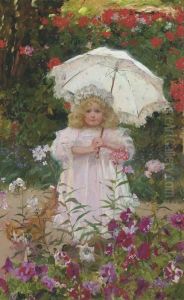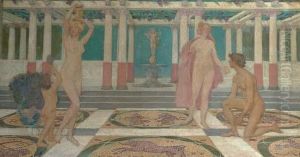Mary L. Fairchild Macmonnies Low Paintings
Mary L. Fairchild Macmonnies Low was an American painter born in 1858, notable for her contributions to the art world during a period when female artists were beginning to gain recognition for their talents and perspectives. Her life and career spanned a transformative era in art history, from the late 19th century through the early decades of the 20th century, a time marked by the emergence of new artistic movements and a growing acceptance of women in the professional art sphere. Mary's work and legacy are a testament to her skill, determination, and the evolving role of women in the arts during her lifetime.
Mary began her artistic journey at a young age, showing a keen interest and natural aptitude for painting. She pursued formal education in the arts, which was a significant achievement for women at the time, given the societal expectations and limitations placed on them. Her talent and hard work led her to study in the United States and later in France, where she was exposed to the vibrant art scene and the innovative styles that were emerging in Europe. It was in France that Mary's artistic style flourished, influenced by the Impressionist movement, which emphasized light, color, and everyday subjects.
In 1888, Mary married Frederick MacMonnies, a fellow American artist, and the couple became central figures in the American expatriate artist community in Giverny, France, famously associated with Claude Monet. Her marriage to MacMonnies and later to Will Hicok Low, another notable artist, placed her at the heart of the artistic movements of her time. Mary's work during this period reflects the impressionistic style, with soft, fluid brushstrokes and a bright palette that captured the ephemeral qualities of light and atmosphere.
Despite the challenges of pursuing a career as a female artist, Mary L. Fairchild Macmonnies Low achieved considerable success and recognition in her lifetime. Her paintings were exhibited in prestigious venues, including the Paris Salon and the World's Columbian Exposition in Chicago in 1893, where she received critical acclaim. After her return to the United States, she continued to paint, exhibit, and contribute to the American art scene until her death in 1946.
Mary L. Fairchild Macmonnies Low's legacy is one of perseverance, talent, and the breaking of barriers for women in the arts. Her body of work continues to be celebrated for its beauty, sensitivity, and contribution to the impressionist movement. Through her achievements, she paved the way for future generations of female artists, making her an enduring figure in the history of American art.


